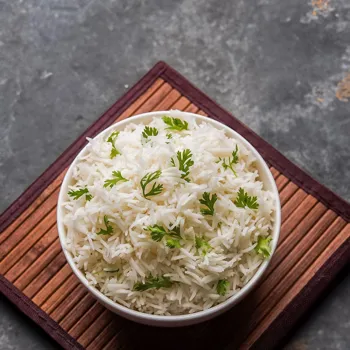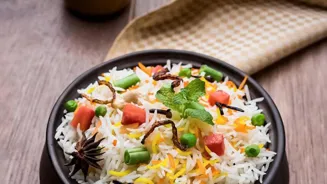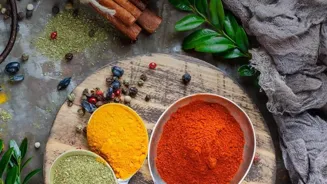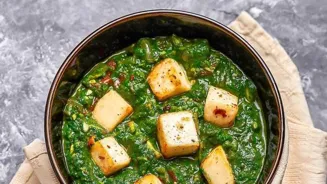Unveiling the Magic of Vegetarian Biryani: Tips, Tricks, and Recipes! Delve into the secrets of perfect biryani creation
Biryani! The very word conjures up images of fragrant rice, delicately spiced vegetables,
and a symphony of aromas that dance in the air. This iconic dish, a staple in Indian celebrations and everyday meals, seems simple enough.
However, achieving biryani perfection, that elusive combination of fluffy rice, flavorful vegetables, and a harmonious blend of spices, requires a touch of artistry and a dash of insider knowledge.
We're here to unlock the secrets to creating a truly memorable vegetarian biryani, right in your own kitchen.
The foundation of any great biryani lies in the rice. Not just any rice will do. Basmati, with its long grains and delicate aroma, is the undisputed champion.
But the type of basmati matters too! Opt for aged basmati rice, as it contains less moisture and results in a fluffier, less sticky biryani. Before you even think about cooking, remember the cardinal rule: wash, wash, wash that rice! Rinse it under cold water until the water runs clear.
This removes excess starch, preventing the grains from clumping together during cooking. After washing, soaking the rice for at least 30 minutes is crucial. This allows the grains to absorb water evenly, ensuring they cook perfectly and expand to their full potential.
Consider adding a teaspoon of lemon juice or vinegar to the soaking water - this helps keep the grains separate and adds a subtle brightness to the final dish.
Finally, when partially cooking the rice, use plenty of water and add a touch of salt, a bay leaf, and a few whole spices like cloves and cardamom for an extra layer of aroma.
Vegetable selection is where you truly get to express your culinary creativity.
While potatoes, carrots, peas, and beans are classic choices, don't be afraid to experiment! Mushrooms, cauliflower, bell peppers, and even paneer (Indian cheese) add unique textures and flavors to your biryani.
The key is to ensure that all the vegetables are cut into evenly sized pieces so that they cook at the same rate. Before incorporating them into the biryani, lightly sauté the vegetables with a blend of spices.
This pre-cooking step ensures that they are tender and flavorful, rather than bland and undercooked in the final dish. Think of this step as building the flavor base for your biryani. Don't overcrowd the pan while sautéing.
Work in batches if necessary, to achieve even browning and prevent the vegetables from becoming soggy. And remember, a touch of ginger-garlic paste adds a delightful aromatic depth to the vegetable mixture.
A pro tip: marinate paneer pieces in a mixture of yogurt, ginger-garlic paste, and spices for at least 30 minutes before sautéing for extra flavor and tenderness.
Ah, the spices! The very soul of biryani. This is where the magic truly happens.
Turmeric, cumin, coriander, garam masala, and chili powder are the usual suspects, but experiment with different combinations and proportions to find your signature blend. Remember that the quality of your spices greatly impacts the taste of your biryani.
Opt for fresh, whole spices whenever possible, and grind them yourself for the most intense flavor.
As a starting point, consider the following spice blend: 1 tablespoon of coriander powder, 1 teaspoon of cumin powder, 1/2 teaspoon of turmeric powder, 1 teaspoon of garam masala, and 1/4 teaspoon of chili powder (adjust to your spice preference).
You can also add a pinch of saffron soaked in warm milk to give your biryani a vibrant color and a subtle, luxurious aroma. Don't be afraid to experiment with other aromatic spices like star anise, mace, and nutmeg, but use them sparingly as they can be quite potent.
The key is to find a balance that complements the other ingredients and doesn't overpower the dish.
The layering technique, known as the "dum" method, is what sets biryani apart from other rice dishes.
It involves partially cooking the rice and the vegetable mixture separately, then layering them in a heavy-bottomed pot, sealing it tightly, and cooking it over low heat. This allows the flavors to meld together beautifully, resulting in a fragrant, tender, and flavorful biryani.
Begin by spreading a layer of cooked rice at the bottom of the pot. Next, add a layer of the sautéed vegetables. Repeat these layers, finishing with a final layer of rice. Drizzle a generous amount of ghee (clarified butter) over the top layer of rice for added richness and aroma.
You can also sprinkle some fresh coriander leaves and mint leaves for a pop of freshness. The most crucial part of the "dum" process is sealing the pot tightly. You can use a tight-fitting lid and seal it with dough or aluminum foil to prevent steam from escaping.
Cook the biryani over very low heat for about 20-25 minutes, or until the rice is fully cooked and the flavors have melded together. Resist the urge to open the pot and stir the biryani during the "dum" process, as this will release the steam and disrupt the cooking process.
Resting the biryani after cooking is just as important as the cooking process itself. Once the "dum" is complete, turn off the heat and let the biryani rest in the pot for at least 10-15 minutes before opening the lid. This allows the steam to settle and the flavors to further develop.
Gently fluff the biryani with a fork before serving, being careful not to break the rice grains. Serve hot, garnished with fresh coriander leaves and a side of raita (yogurt dip). Raita, made with yogurt, cucumber, and spices, provides a cooling counterpoint to the richness of the biryani.
You can also serve it with a simple salad or a pickle for added flavor and texture. And there you have it – a perfectly cooked, flavorful, and aromatic vegetarian biryani that is sure to impress your friends and family.
Now, let's dive into a couple of easy-to-follow recipes to get you started on your biryani journey:
Simple Vegetable Biryani Recipe
Ingredients:
2 cups Basmati rice
4 cups Water
1 tbsp Ginger-garlic paste
1 tsp Turmeric powder
1 tsp Garam masala
1/2 tsp Red chilli powder
1 cup mixed vegetables (carrots, peas, beans, potatoes)
1/2 cup chopped onions
1/4 cup chopped coriander leaves
2 tbsp Ghee
Salt to taste
Instructions:
Wash and soak rice for 30 minutes.
Sauté onions and ginger-garlic paste in ghee until golden brown.
Add vegetables, turmeric powder, garam masala, and chilli powder. Cook for 5-7 minutes.
Cook rice with water and salt until 70% done.
Layer rice and vegetable mixture in a pot.

Drizzle ghee and sprinkle coriander leaves.
Dum cook on low heat for 20 minutes.
Rest for 10 minutes before serving.
2 cups Basmati rice
4 cups Water
200g Paneer, cubed
1 tbsp Ginger-garlic paste
1 tsp Turmeric powder
1 tsp Garam masala
1/2 tsp Red chilli powder
1/2 cup chopped onions
1/4 cup chopped mint leaves
1/4 cup chopped coriander leaves
2 tbsp Ghee
Salt to taste
Instructions:
Wash and soak rice for 30 minutes.
Marinate paneer with ginger-garlic paste, turmeric powder, garam masala, and chilli powder for 30 minutes.
Sauté onions until golden brown. Add marinated paneer and cook for 5 minutes.
Cook rice with water and salt until 70% done.
Layer rice and paneer mixture in a pot.
Drizzle ghee and sprinkle mint and coriander leaves.
Dum cook on low heat for 20 minutes.
Rest for 10 minutes before serving.
With these tips, tricks, and recipes, you're well on your way to mastering the art of biryani making.
So, gather your ingredients, put on your apron, and get ready to create a culinary masterpiece that will tantalize your taste buds and impress your loved ones. Happy cooking!
AI Generated Content. Glance/InMobi shall have no liability for the content









